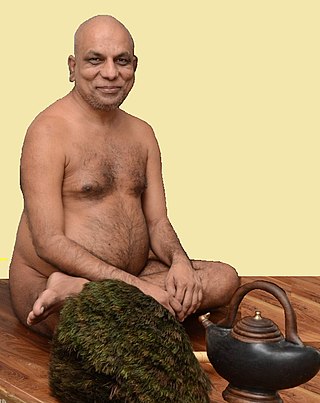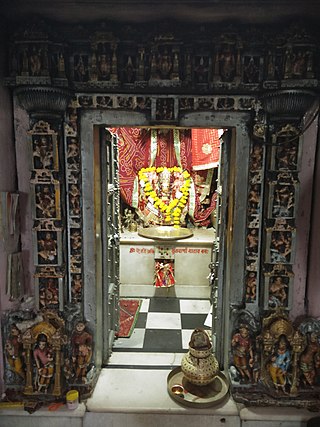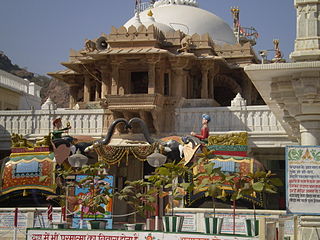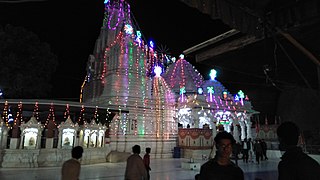| Part of a series on |
| Jainism |
|---|
 |
The Dugar (also called Duggar, Duggad, Dugad) is a gotra belonging to the Jain Oswal community of Rajasthan. [1]
| Part of a series on |
| Jainism |
|---|
 |
The Dugar (also called Duggar, Duggad, Dugad) is a gotra belonging to the Jain Oswal community of Rajasthan. [1]

According to Mahajan Vansh Muktavali by Yati Ramlal ji,
The King of Marwar, Rao Surdeo Khich was a brave Rajput King . [2] He had two sons, named Dugar and Sugad.The Origin of Rao Surdeo Khich (and Dugar and Sugad of course) was from Chauhan King of Bisalpur (Neighbouring Gulabpura & Bijaynagar, Between Ajmer & Bhilwara) . Both the brothers established a new city Aghat in Mewar.Around Aghat there were colonies of Bheels and Meenas (criminal tribes).Once the criminal tribes surrounded the Aghat City and started killing the innocent people, both the brothers arrested and punished them. When the Rawal of Chittorgarh Rana Berisal Singh Sisodia heard that Dugar and Sugad had arrested such notorious criminals; he became pleased and called them to his palace and honoured them with the title of Shri Raoraja. [3] [4]
There was an old temple of Naharsingh Devta outside the boundary of Aghat City. The people of Aghat destroyed the temple so Devta became angry, and began to create nuisance and violence in the city and started torturing and killing the women and children. Both of the Raorajas Dugar and Sugad tried a lot but failed to stop him. [4] [5]
Then coincidentally, Manidhari Acharya Shri Jinchandra Suri came to Aghat city and were notified about the nuisance created by Dave. Acharya Shri prayed to Padmavati Devi and asked her to come and help them. Padmavati Devi appeared and caught Naharsingh Dave and ordered him to not create trouble anymore. [4] [5]
By seeing this miracle, both the brothers adopted Jainism. Manidhari Acharya Shri Jinchandra Suri made them Oswals in V.S. 1217 (Around 1160 A.D.) and their gotras were named Dugar and Sugad. [4]
Chittorgarh Nawab Berisal Singh Sisodia was so impressed by this incident that he also became Oswal and adopted Jainism. His gotra was named Sisodia. His Deewaan Khetani also became Oswal, so his family was named Khetani. [4] [6] [7]
However, according to the historian Dr J.P.Krishnanthan, Acharya Shri Shidchandra Suri arranged a sangh to Shatrunjaya, where 1,700 people converted to Jainism. Both Dugar and Sugar were also impressed by words of Acharya Shri Shidchandra Suri and they also converted to Jainism under him. [2]
The book Oswal Jati Ka Ithias by SukhsampatrajBhandari traces the lineage of Dugars to the Chauhan Dynasty of Bilaspur. [8]
Goddess Ambe incarnated as Suswani Mata and was born to Sri Seth Satidasji and Srimati Sugankanwarji of Nagaur in V.S. 1219. Her marriage was fixed at the age of 10 in the Dugar family. She was very beautiful. On the day of her pre-marital function, the nawab of Nagaur was allured by her beauty and fell in love with her. He expressed his wish to marry 'Suswani' in front of her father, but her father said that the girl was an incarnation of the Mata Ambe and it was not in his power to bestow her on any body. As marital relationship between Hindu and Muslim was not possible her father rejected the proposal. The nawab got furious and threatened to kill the whole family and imprisoned Seth Satidas . The entire family blamed Suswani ji for the whole incident. Suswani ji became upset and started praying to Lord Arihant and felt asleep. [9]
In her sleep she saw a dream of an enlightened idol assuring her not to worry. The idol told Suswani ji to inform the nawab that she would marry him, if he fulfills the condition laid down by her. The condition was that,"She would be at a distance of 7 feet from him and he should catch her by following her either barefooted or on a horse.However he will never be able to catch her."
"नैन मूंद अरिहन्त को ध्यायी। ध्यान ही ध्यान में निन्दिया आई। स्वप्न में तेजस्वी भगवान ने दर्शन देकर कहा वचन में।। घबराने की बात नहीं है उसकी ये औकात नहीं है।। तू उस दुष्ट को ये कहलादे शर्त रखी है तेरे आगे।। सात पांवड़े की छूट देकर पीछा कर ले घोड़े चढ़कर।। वो तुझको नहीं पकड़ पायेगा दौड़-दौड़ कर थक जायेगा।। "
– Suswani Mata Ki Gatha
The proof of this dream would be the saffron tilak on the forehead of her family members, in the morning and the idol disappeared. Suswani woke up and narrated the entire dream to her mother and found the saffron tilak on the forehead of the family members.
All the members were pacified and thereafter the message was sent to the nawab. The nawab agreed to her terms and was extremely happy. Sethji was freed from the prison. Very soon nawab with a few soldiers arrived at Sethji's palace. Suswani ji left the imprints of the kumkum hand on the wall near the front door of the house, before starting to run. As per the condition, she started running on foot, and the evil nawab on the horse leaving a gap of 7 feet in between them. [10] [11] The nawab was unable to catch her, although he was on a horse and the distance remained the same. She kept on running and when she got tired, she prayed for help. Immediately a lion appeared on which she mounted and continued running up to the present Bikaner district's Morkhana village. There she saw a shrine of Lord Shiva and prayed for help. Lord Shiva appeared in front of her and threw a chimta in front of the temple, amidst a Kera tree . As soon as Suswani reached the place, the Kera tree and the earth parted in two making a thunderous sound. [12] Suswani ji entered into the earth with the lion and the earth closed up again, leaving a small part of her saree out . [13] The Nawab and his friends fought for the pallu and killed each other. The divine shrine of Morkhana still witness the fully bloomed Kera tree. [14] [15]
In V.S. 1232, Malhadas Surana, the younger brother of Seth Satidas Surana, saw a dream in which Suswani ji in the form of Devi, ordered him to construct a temple at the place where she entered into the earth. He expressed his inability due to lack of money. Devi told him about a place with hidden treasure in his goshala. Malhadas constructed the temple, a well and a Goshala with the help of that money. When Malahdas Surana expressed the lack of money to construct the temple, Devi told him about a place with hidden treasure in his Goshala. Malahdas constructed a temple of Suswani Mataji with the help of that money. [16]

Since then Suswani Mataji is the Kuldevi of Dugar as well as Surana and Sankhala Gotras. Her temple is situated at Morkhana, in Bikaner District, India. [17] [18]
The four categories of Dugar's under Shwetamber sect are Sthanakwasi, Terapanthi, Sheharwali and Murtipujak. [19] [20]

Brahmani or Brahmi, is one of the seven Hindu mother goddesses known as Sapta Matrikas. She is a form of Saraswati and is considered as the Shakti of the creator god Brahma in Hinduism. She is an aspect of Adi Shakti, possessing the "Rajas Guna" and is therefore the source of Brahma's power.

Acharya Shri Vidyasagarji Maharaj is a Digambara Jain Acharya. He is recognized both for his scholarship and tapasya (austerity). He is known for his long hours in meditation. While he was born in Karnataka and took diksha in Rajasthan, he generally spends much of his time in the Bundelkhand region where he is credited with having brought about a revival in educational and religious activities. He has written haiku poems and the epic Hindi poem "Mukamati".

In Jain cosmology, Chakeshvari or Apraticakra is the guardian goddess or Yakshini of Rishabhanatha. She is the tutelary deity of the Sarawagi Jain community.

Sundha Mata temple is a nearly 900-year-old temple of Mother goddess Chamunda situated on a hilltop called Sundha, located at Longitude 72.367°E and Latitude 24.833°N, in Jalore District of Rajasthan. It is 64 km (40 mi) from Mount Abu and 20 km (12 mi) from the town of Bhinmal.

Sardarshahar is a city located in the Churu district of Rajasthan, India. It is also the seat of the Rajasthan legislative assembly Sardarshahar Assembly constituency. Sardarshahar is the tehsil headquarter. and part of the Churu Lok Sabha constituency. Sardarshahar was established in 1838 at the place of "Alwana" village in Bikaner state. The city is named after Sardar Singh, The son of Bikaner Maharaja(Raja Ratan Singh). It is known for its grand Havelis (mansions) with frescoes, The only Clock Tower (GhantaGhar) in Asia which streets running under it in all four directions, Shri Ichha Puran Balaji Mandir, Acharya Shri Mahapragya Samadhi Sthal(ShantiPeeth), Gandhi Vidya Mandir and many more. It is famous for its Food, handicraft work, silver work, and woodwork. It is the birthplace of the Eleventh Acharya -Acharyashri Mahashramanji of the Shri Jain Terapanthi Sect.

A kuladevata, also known as a kuladaivaṃ, is an ancestral tutelary deity in Hinduism and Jainism.
Bapna also spelt Bafana' is an Indian Jain community, and also the surname used by this community. The name is derived from Bahufana and Bafanha. They were Rajput and embraced Jainism. Bafnas are also known as Bapnas, Baphana.

In Jainism, Ambika or Ambika Devi is the yakshini "dedicated attendant deity" or Śāsana Devī "protector goddess" of the 22nd Tirthankara, Neminatha. She is also known as Ambai, Amba, Kushmandini and Amra Kushmandini. She is often shown with one or more children and often under a tree. She is frequently represented as a pair with a small Tirthankar image on the top. The name ambika literally means mother, hence she is Mother Goddess. The name is also a common epithet of Hindu Goddess Parvati.
Deh is a Tehsil in Nagaur district of Rajasthan India
Balonda is a village in the Indian state of Rajasthan. Its mandal is Surajgarh and district is Jhunjhunu. It is located 17.7 kilometres (11.0 mi) from Surajgarh, 54.2 kilometres (33.7 mi) from Jhunjhunu, and 157 kilometres (98 mi) from Jaipur.

Bhadreshwar Jain Temple, also known as Vasai Jain Temple, is a historical importance located in Bhadreshwar village of Mundra Taluka, Kutch, Gujarat, India.

Munishri Pramansagarji Maharaj is a Digambar monk of Terapanth sub-sect. He is an able disciple of Acharya Shri Vidyasagar Ji Maharaj. He has set free the religion from traditional abstruseness and made it practicable in life. Through his sermons and initiatives, the process of a qualitative change in society has begun. He led a campaign to save the Jain tradition of Santhara also known as Sallekhana in the year 2015, in which millions of Jain community members took out massive silent rallies in several cities and towns all over the world against the Rajasthan High Court decision. Gunayatan is one of his important religious initiatives which is going to become a centre for self-development in the true sense. His pravachans and Shanka Samadhan programme are aired on Jinvani Channel and Paras TV Channel.

Muni Shri Sudhasagar Maharaj is a Digambar monk who was initiated by Acharya Vidyasagar.

Karamchand Bachhawat (1542-1607) (विभूति) was the Dewan, Prime Minister of Bikaner State in the former Rajputana from 1571 to 1591. Karamchand, a descendant of Bachhraj, was a valiant warrior, a good administrator and a strategist in Bikaner and had a good relationship with Akbar. In 1591, fearing for his life, he resigned. At Akbar's invitation, Karamchand later joined the emperor as an adviser to the Lahore court.

Suswani Mataji also known as Susani Mata or Susvani Mata is a regional Hindu as well Jain goddess, popular in Rajasthan state of India. She is regarded as incarnation of Durga and worshipped by many Jain and Hindu communities.
Delwara, nestled in the Aravalli Range hills, is a small town about 28 kms away from Udaipur, Mewar, and close to Eklingji Temple, on the way to the temple town of Nathdwara, in the state of Rajasthan, India. Delwara was originally known as ‘Devkul Patan Nagri’, which means the town of god. It boasted over 1500 temples at one time, out of which there were over 400 Jain temples. Delwara was the center of learning and culture before the 15th century AD. Around the middle of the 13th century, Raja Sagar, a Deora Chauhan and a descendant of Rao Kirtipal of Jalore, was a very brave king of Delwara (Mewar). Descendants of Raja Sagar sacrificed their lives whilst fighting alongside Ranas of Mewar against Muslim invaders. Raja Sagar was the progenitor of Bachhawat and Bothra clan of Oswals. Sagar's son, Kunwar Bohitya was immensely influenced and inspired by Jain philosophy. Samdhar, a grandson of Bohitya and a Deora Chauhan, was the first man in his genealogy to convert to Jainism.

Nakodaji Tirth is a major Jain tirth in the Indian state of Rajasthan, located between the villages of Vikrampura and Nakoda in Barmer District. The temple houses the icon of Nakoda Bhairava, a popular Shvetambara guardian deity.

There are 51 Shaktipeeth of Goddess Sati all over the country, one of the main Shaktipeeth is Goddess Kamakhya, where the vaginal part of the Goddess was fallen, apart from this, there are various temples of maa Kamakhya all over the country, one of which is located in the famous village Jai Devi of Sunder Nagar in Mandi district of Himachal Pradesh, which is famous far and wide due to its beliefs and miracles." Kamaksha " word means the goddess who fulfills all kinds of desires.

Shri Kamaksha Temple Jaidevi, also known as the Kul Devi of the Suket royal family and the Raj-Rajeshwari and Adhisthatri Devi of the Suket principality, is a historic Hindu temple surrounded by mountains in a natural setting.

Viratra Mata Temple a 900-year-old temple of Mother goddess Vankal situated on a hilltop called Viratra, located in Barmer of Rajasthan.